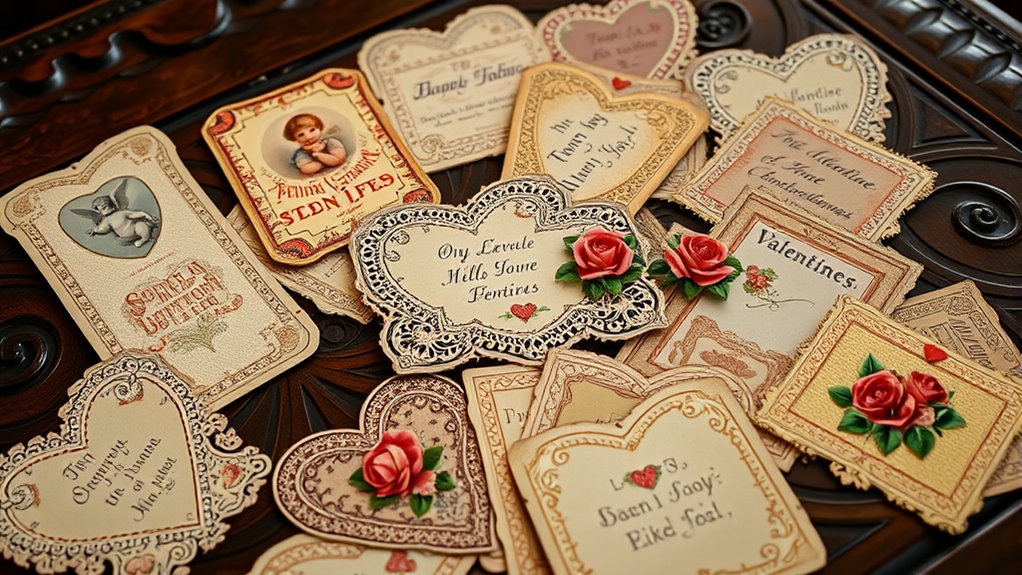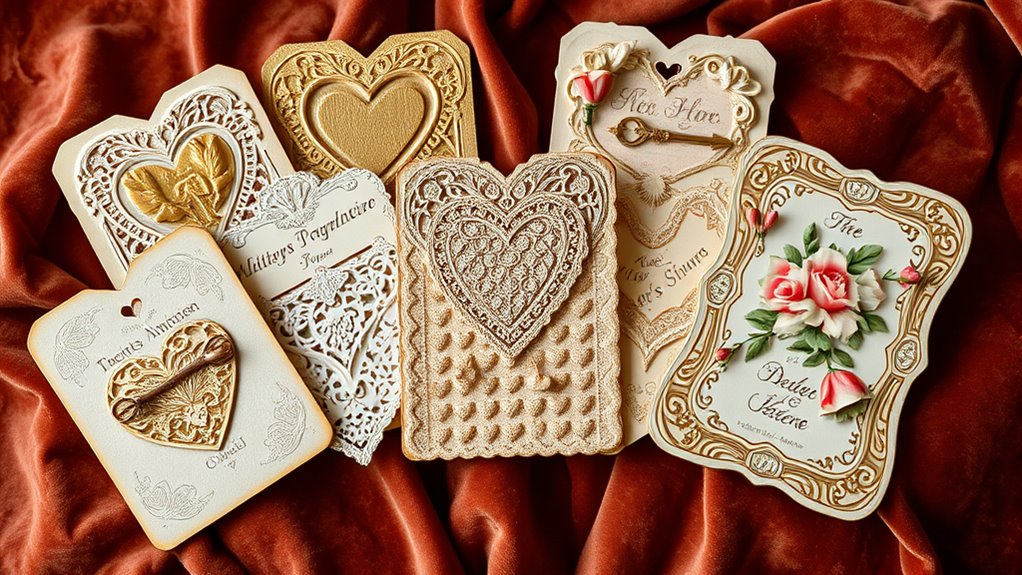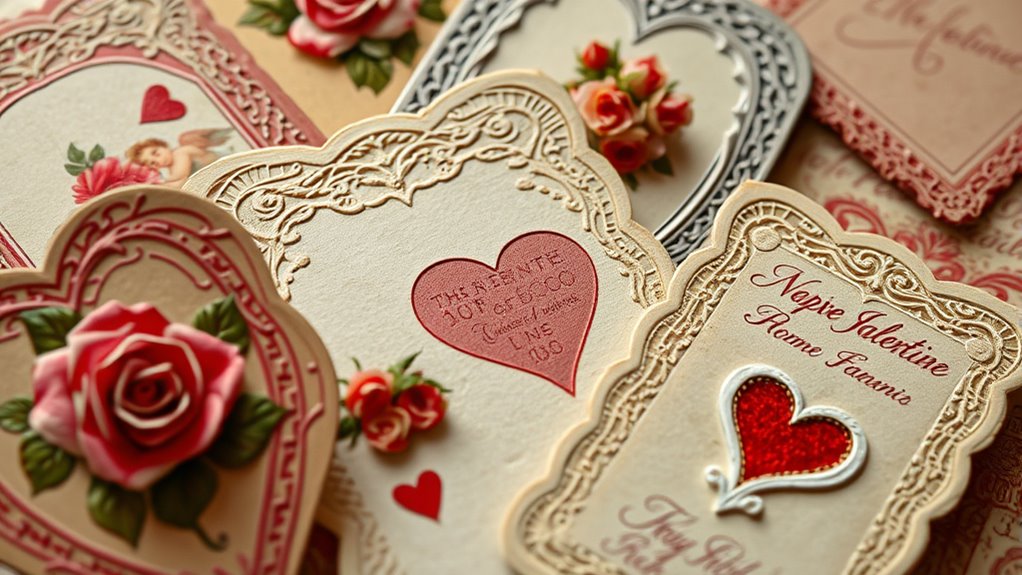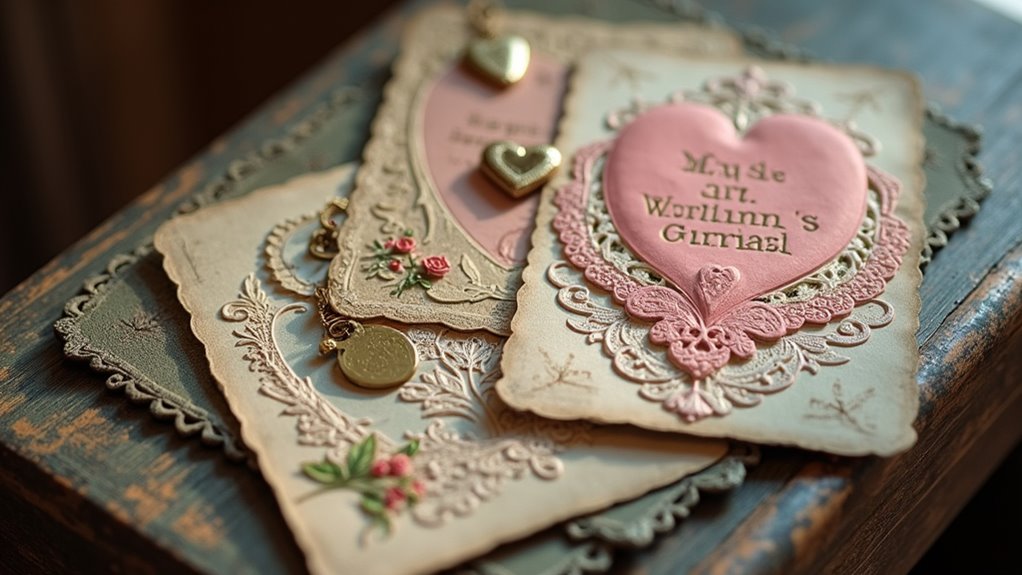Like a secret encoded in delicate paper, Victorian Valentine cards reveal much more than simple messages of love. Their intricate designs and hidden symbols tell stories that go beyond words, reflecting social norms and personal sentiments of the era. As these tokens of affection gained and lost popularity, they left behind a fascinating legacy of craftsmanship and symbolism. To understand their true significance, you’ll need to explore the history and meaning woven into each card.
Key Takeaways
- Victorian Valentine cards originated as handwritten tokens of affection, evolving into elaborate mass-produced designs with intricate craftsmanship.
- They employed symbolic motifs like roses, lilies, and hidden initials to convey layered, discreet messages of love and sentiment.
- The use of color symbolism and floral imagery allowed expressing complex emotions subtly within societal norms of propriety.
- The popularity of these cards declined due to changing social attitudes, evolving communication methods, and shifting cultural values.
- Collecting and preserving Victorian Valentine cards provides insight into historical romance, social customs, and the craftsmanship of the era.
The Origins of Victorian Valentine Cards

Victorian Valentine cards began as handwritten notes exchanged between lovers and friends, but their popularity quickly grew with the advent of printing technology. During this period, cultural influences from Romantic ideals and the rise of mass-produced goods shaped the way people expressed affection. The historical context also played a role, as increased literacy and expanding commerce made greeting cards more accessible. Victorian society valued sentimentality and symbolism, which influenced the design and message of these cards. They reflected societal norms around courtship and emotional expression, often embedding subtle meanings and coded symbols. These cultural and historical factors combined to elevate Valentine cards from simple notes to cherished tokens of love, setting the stage for their enduring popularity and evolving symbolism in the years that followed. Additionally, the use of symbolism in design helped convey messages that might have been considered too personal or risqué to speak aloud at the time.
Craftsmanship and Design: The Art of Card Making

The artistry behind Victorian Valentine cards transformed simple messages into intricate works of craftsmanship. You’ll notice the embellished craftsmanship that elevates each card, showcasing delicate details and fine materials. The intricate design often includes embossed patterns, lace-like cutouts, and layered embellishments that demonstrate skill and patience. Artists used vibrant colors, gold leaf accents, and decorative borders to enhance visual appeal. Every element was carefully crafted, reflecting the importance placed on personal expression and aesthetic beauty. These cards weren’t just messages—they were miniature works of art, designed to impress and delight the recipient. The use of vintage decor elements, such as ornate frames and antique motifs, further accentuated the handcrafted nature of these treasured cards. Your appreciation of Victorian Valentine cards deepens when you see how much effort and artistry went into creating these exquisite, handcrafted treasures.
Symbolism and Hidden Meanings in Victorian Valentines

During the Victorian era, Valentine cards often carried hidden messages and symbolic imagery that conveyed feelings beyond words. You might notice botanical illustrations, such as roses or lilies, representing love or purity. Color symbolism played a key role, with red denoting passionate love, white symbolizing innocence, and yellow indicating friendship. To decode these messages, look for:
- Botanical illustrations like ivy or violets, symbolizing fidelity or modesty.
- Specific colors used in the design, revealing the sender’s true feelings.
- Hidden initials or monograms embedded within the artwork.
- The use of specific motifs like hearts or doves to express affection or peace.
- Symbolism and Hidden Meanings in Victorian Valentines allowed senders to communicate complex emotions discreetly, making each card a layered expression of sentiment.
Societal Norms and the Role of Courtship

Societal norms in the Victorian era heavily shaped how courtship unfolded, emphasizing propriety, modesty, and strategic behavior. You had to follow strict social etiquette, where every gesture and word conveyed your intentions carefully. Gender roles dictated that men took the initiative, while women remained reserved and modest, often communicating their interest through subtle signals. Courtship was a delicate dance, designed to uphold reputation and social standing. Public displays of affection were frowned upon, so letter writing and token exchanges like Valentine cards became crucial methods of expressing affection discreetly. Understanding and respecting these norms was essential; it guaranteed that your advances aligned with societal expectations, helping you navigate the complex balance between desire and decorum in Victorian society. Additionally, innovations like bank SWIFT/BIC codes were not yet in use during this period but exemplify the importance of secure and standardized methods of communication and transaction in modern society.
Popular Motifs and Their Meanings

You’ll notice that Victorian Valentine cards feature many romantic symbols like hearts, roses, and doves, each carrying specific meanings. These motifs often conveyed feelings that words couldn’t express openly, especially within strict social norms. By understanding these symbols, you can uncover the hidden messages Victorian lovers shared through their cards. Additionally, the use of aura colors in artwork and symbolism can subtly reflect the emotional and spiritual states associated with these motifs.
Romantic Symbols Explored
Victorian Valentine cards are rich with symbols that convey deep emotions and intentions, often simpler than words but just as meaningful. You’ll notice botanical motifs like roses, violets, and lilies, each carrying specific romantic meanings. Color symbolism also plays a key role: red signifies passionate love, pink indicates admiration, and white represents purity. To better understand these symbols, consider these common motifs:
- Roses: love and desire
- Violets: faithfulness and modesty
- Lilies: purity and innocence
- Hearts: affection and emotional connection
These symbols allow you to express complex feelings subtly, transforming simple images into powerful messages of love. By recognizing botanical motifs and color symbolism, you gain insight into Victorian romantic expressions hidden within these charming cards.
Hidden Meanings Unveiled
Many Victorian Valentine motifs carry hidden messages that deepen their romantic significance, allowing you to convey feelings subtly but meaningfully. Symbols like puzzle games represented the idea of solving or *releasing* love, while floral arrangements often carried specific meanings—like red roses for passion or lilies for purity. These motifs enabled you to send layered messages without words. For example, a card featuring intertwined flowers could symbolize unity, while a puzzle game hinted at a love needing to be figured out. Understanding these symbols reveals the thoughtfulness behind Victorian cards. Here’s a quick guide: color symbolism
| Motif | Hidden Meaning | Example Use |
|---|---|---|
| Puzzle Games | Love’s mystery to solve | “Can you solve my heart?” |
| Floral Arrangements | Specific feelings | Red roses = passion, lilies = purity |
| Intertwined Flowers | Unity and commitment | “Together forever” |
These motifs made your Valentine’s message more personal and intimate.
The Decline of Victorian Valentine Cards

What caused the once-thriving tradition of Victorian Valentine cards to decline? Several factors played a role. First, changing Victorian fashion made elaborate cards less appealing as styles shifted. Second, Victorian etiquette emphasized formality, making personal expressions through cards seem less appropriate. Third, advances in printing technology lowered costs, but also flooded the market, reducing their special value. Fourth, societal shifts toward more direct communication methods, like the telephone, diminished the need for sentimental cards. As the era progressed, these elements combined to make Victorian Valentine cards less fashionable and meaningful. Additionally, the influence of cultural change and evolving social norms contributed significantly to the decline of this romantic tradition. The rise of modern communication, paired with evolving social norms, ultimately led to their decline, ending a cherished Victorian tradition.
Collecting and Preserving Victorian Valentines Today

Today, collecting and preserving Victorian Valentine cards offers a fascinating glimpse into a bygone era of romance and social customs. As a collector, you’ll appreciate using eco-friendly materials to protect these delicate treasures, such as acid-free storage boxes and environmentally conscious preservation techniques. Modern collection methods, like digital cataloging and careful handling, help maintain their condition and historical value. You might seek out authentic cards with intricate details, paying attention to their unique symbolism and craftsmanship. Preservation involves controlling light, humidity, and temperature, ensuring these artifacts survive for future generations. Additionally, understanding cookie categories can inform how digital archives are accessed and secured, helping to protect the privacy and integrity of your collection. By combining eco-friendly practices with contemporary techniques, you can responsibly safeguard Victorian Valentines, preserving their charm and significance while honoring their cultural importance.
Decoding the Secrets Behind the Cards

Victorian Valentine cards often hide secret symbols and motifs that reveal deeper feelings. You’ll notice romantic codes and clever puns that add layers of meaning beyond the words. Understanding these clues helps you uncover the true intentions behind each heartfelt message. Additionally, some symbols may have been used to subtly communicate messages in an era when open expression of affection was sometimes constrained by social norms ethical hacking, emphasizing the importance of interpreting hidden signals.
Hidden Symbols and Motifs
Have you ever wondered what hidden messages Victorian Valentine cards concealed beneath their ornate designs? These cards often used symbols rooted in medieval symbolism and floral motifs to convey deeper meanings. You might notice:
- Lily representing purity and innocence
- Roses symbolizing love and passion
- Clovers indicating luck or hope
- Serpents or dragons denoting protection or temptation
Victorian artists embedded these motifs intentionally, allowing the sender to communicate feelings subtly. Floral motifs, especially, played a significant role, with each flower carrying a specific message. Medieval symbolism influenced these choices, creating layers of meaning beneath the decorative surface. Recognizing these symbols reveals the true sentiments Victorian senders wished to express, often hidden behind ornate artistry. Additionally, understanding symbolic motifs can deepen appreciation for the cultural context of these cards.
Romantic Codes and Puns
Ever wonder how Victorian Valentine cards secretly conveyed love and affection beyond their decorative designs? They used romantic codes and puns rooted in language evolution and floral symbolism. Words were carefully chosen to hint at feelings without explicit declaration, allowing senders to express emotions subtly. Puns like “I’ll be your Valentine” or “You’re my perfect bloom” cleverly played on language shifts of the era, making messages more personal and playful. Floral symbolism further enriched these messages—roses signified love, lilies purity, and violets devotion—adding layers of meaning beyond words. By decoding these puns and symbols, you can uncover the heartfelt intentions behind each card. These romantic codes created a private language, making Victorian Valentine exchanges both charming and discreet.
Frequently Asked Questions
How Did Victorian Valentine Cards Influence Modern Greeting Card Designs?
You see, Victorian Valentine cards greatly influenced modern greeting card designs by popularizing romantic motifs and diverse artistic styles. They introduced intricate illustrations, heartfelt messages, and symbolic decorations that remain common today. These cards set a standard for personalization and emotional expression, inspiring contemporary creators to blend visual art with sentimentality. As a result, your modern greeting cards often reflect the rich symbolism and artistic elegance first seen in Victorian Valentine traditions.
Were Victorian Valentine Cards Used Across All Social Classes Equally?
Like ripples on a pond, Victorian Valentine cards didn’t reach everyone equally. You might notice social class disparities and regional variations shaping their use. Wealthier classes embraced elaborate designs, while lower classes often received simpler cards or none at all. This divide reflects the broader societal gaps of the era, making you realize that these cards, though charming, often mirrored the social boundaries of Victorian society.
What Materials Were Commonly Used in Victorian Valentine Card Production?
You’ll find Victorian Valentine cards were crafted with a variety of materials, reflecting both materials exploration and decorative techniques. Cardmakers used thick paper, embossed cardstock, and delicate fabrics like lace or silk to add texture. They also incorporated vibrant colors through dyes and inks, and added embellishments such as metallic foil, ribbons, and intricate cut-outs. These choices made each card a tactile and visual delight, showcasing the craftsmanship of the era.
Did Victorian Valentine Cards Ever Include Secret Messages or Coded Language?
You might find it surprising, but Victorian Valentine cards often included secret messages and coded language. People used these hidden symbols to express affection subtly, avoiding social embarrassment. Secret messages could be concealed within intricate designs or coded in symbols like flowers and colors. This clever communication allowed lovers to share feelings privately, knowing only they understood the true meaning behind the charming, often elaborate, Victorian Valentine cards.
How Did the Symbolism in Victorian Valentine Cards Reflect Gender Roles?
You notice that Victorian Valentine cards use symbolism to reflect gender expectations and emotional expression. Men often received symbols of strength and protection, like swords or lions, emphasizing traditional masculinity. Women’s cards featured delicate flowers and hearts, highlighting tenderness and emotional depth. This symbolism reinforced societal roles, showing men as protectors and women as nurturers, shaping how emotional expression and gender identity were communicated through these sentimental tokens.
Conclusion
As you explore Victorian Valentine cards, imagine uncovering a hidden language, like a secret handshake in a world of whispers. These cards were more than pretty pictures—they were coded messages of love and longing, carefully crafted behind embossed blooms and subtle symbols. Just as a single rose can speak volumes, these cards reveal the depth of Victorian romance. Preserving them is like keeping a delicate whisper of history alive, echoing love’s timeless secrets.








